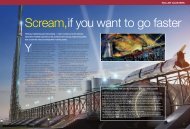Cisco - TABPI
Cisco - TABPI
Cisco - TABPI
You also want an ePaper? Increase the reach of your titles
YUMPU automatically turns print PDFs into web optimized ePapers that Google loves.
NEWS&ANALYSIS<br />
Face to Face: Clark Masters<br />
Sun aims high<br />
VP SEES LOTS OF VIGOR LEFT IN HIGH-PERFORMANCE COMPUTING<br />
In recent months, sun<br />
Microsystems Inc. has<br />
made a big push into lowend,<br />
low-cost computing.<br />
The Santa Clara, Calif.,<br />
company rolled out blade<br />
servers as part of its N1 data<br />
center virtualization strategy,<br />
as well as two low-end x86<br />
servers, and promised to<br />
continue providing more of<br />
the same. But high-end Unix<br />
systems are still an important<br />
part of Sun’s overall strategy,<br />
and Clark Masters, executive<br />
vice president and general<br />
manager of the company’s<br />
Enterprise Systems Products<br />
group, spoke with eWeek Senior<br />
Editor Jeffrey Burt about<br />
Sun’s plans for its top-of-the<br />
line servers.<br />
Low-end servers and blade<br />
servers have gotten a lot of<br />
publicity. What is Sun doing<br />
with high-end servers?<br />
I think the high end matters<br />
more today than ever,<br />
really. At the $500,000-andup<br />
price point—these are<br />
[International Data Corp.]<br />
data, not Sun data—in the<br />
year 2000, it was 20-someodd<br />
cents out of every server<br />
dollar was spent on the halfmillion-<br />
dollar-and-up market<br />
range. At the end of 2002,<br />
that was over 30 cents, so that<br />
the amount of IT dollars<br />
going toward the high end ...<br />
is larger today than ever<br />
before.<br />
Is this because the systems are<br />
more expensive or because there’s<br />
24 eWEEK n MAY 26, 2003<br />
Masters: High-end spending climbing.<br />
a growing demand for them?<br />
It’s two things. The weakness<br />
in the market we see is more<br />
the midrange.<br />
So we’re seeing [high-end<br />
server growth] with server consolidation<br />
and data center<br />
consolidation and the drive<br />
toward efficiency. Also, we’re<br />
seeing strength in government<br />
spending, high-performance<br />
technical computing [HPTC],<br />
all of those things.<br />
What’s driving the demand for<br />
the really high end?<br />
Two or three key factors that<br />
I see. One is server consolidation.<br />
Two years ago, when<br />
I talked with customers, it was<br />
all about staying out in front<br />
of the wave. ... It was the dotcom<br />
boom times. It was all<br />
about deployment.<br />
Now, today, it’s all about<br />
doing more with less—total<br />
cost of ownership. How do I<br />
drive costs out of the system?<br />
Another thing is, most<br />
large organizations are<br />
structured in business<br />
units, and a lot of business<br />
units have their own IT<br />
infrastructure, and now I<br />
think the political walls are<br />
broken down, that cost<br />
control is much more<br />
important than the autonomy<br />
of a particular business<br />
unit. You see people,<br />
to save costs, much<br />
more willing to consolidate<br />
workloads and combine<br />
computing environments,<br />
and that helps drive the<br />
high-end server business<br />
and data-center-class machines.<br />
Regarding N1, can you provide<br />
me with an idea of how<br />
Sun’s largest servers—the 12K<br />
and the 15K—fit in with that<br />
strategy?<br />
With N1, the better we can<br />
do at driving up the utilization<br />
and efficiency, the<br />
more applications we<br />
can dynamically provision.<br />
That’s a huge<br />
opportunity for us. So<br />
with the software tools<br />
we’re developing with<br />
N1, to manage and<br />
provision it, plus the<br />
virtualization in the hardware<br />
with domain and the Solaris<br />
operating environment, with<br />
resource management and<br />
software partitions—or containers—we<br />
have very powerful<br />
technologies to leverage,<br />
to simply be the best in the<br />
world at that.<br />
How important is HPTC to<br />
Sun’s high-end computing strategy?<br />
It’s very important to Sun up<br />
and down the product line.<br />
... We’re developing visualization<br />
technology like Java<br />
3-D, for example. That’s big in<br />
the research and technical<br />
computing area.<br />
We’re finding that technical<br />
[computing] has much more<br />
growth potential and is becoming<br />
much more integrated with<br />
most every organization,<br />
whether it be manufacturing<br />
to do design optimization<br />
before you actually do implementations<br />
to biotech companies.<br />
What are some of the other areas<br />
in HPTC that Sun needs to<br />
address?<br />
We’re very good at large physical<br />
memory, so that gives us<br />
an advantage. High-bandwidth<br />
I/O we have.<br />
We have a storage business<br />
and very good technology<br />
there. When we get our Ultra-<br />
SPARC 4 machines—and I<br />
think in the worldwide analyst<br />
conference I said we would be<br />
introducing those before the<br />
next analyst conference, so<br />
about year-end or early part of<br />
next calendar year—that will<br />
have multiple threads ... so it<br />
will double the floating-point<br />
performance that we have in<br />
the same footprint.<br />
‘Today, it’s all about<br />
doing more with<br />
less—total cost<br />
of ownership.’<br />
Long term, we’re investing<br />
in additional cluster technologies;<br />
investing in InfiniBand<br />
for high-speed networking,<br />
for both I/O and machines to<br />
machines; and also new processor<br />
technologies and interconnect<br />
technologies aimed<br />
at HPTC. ´













